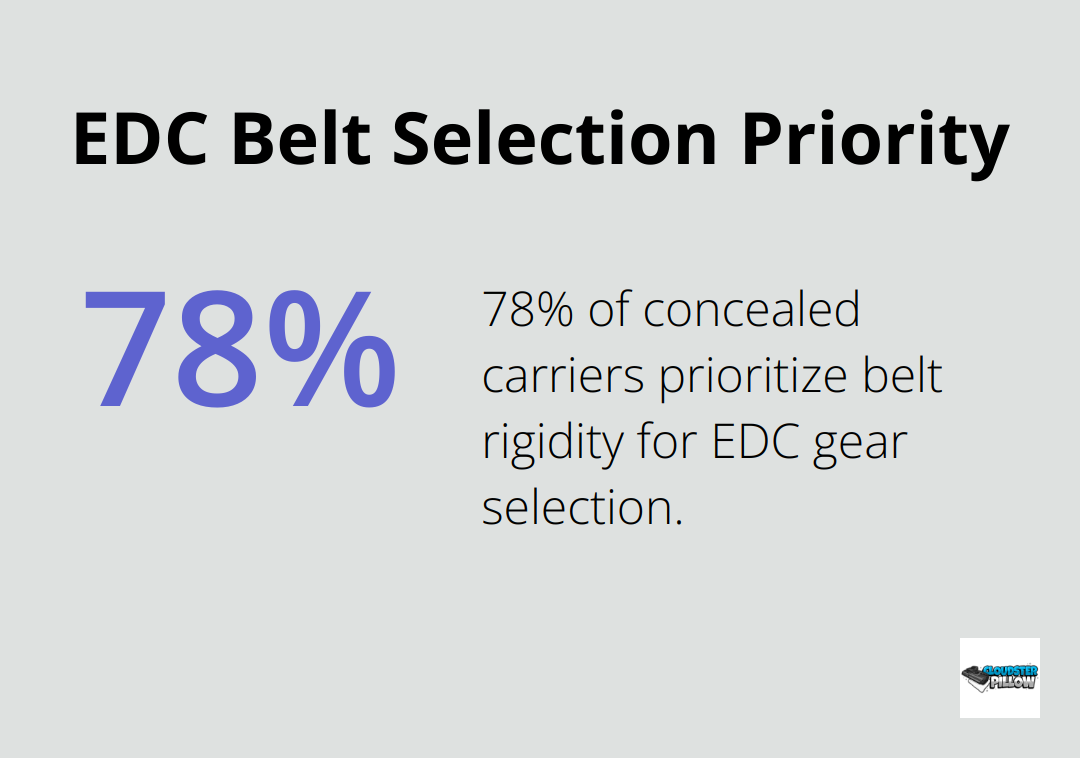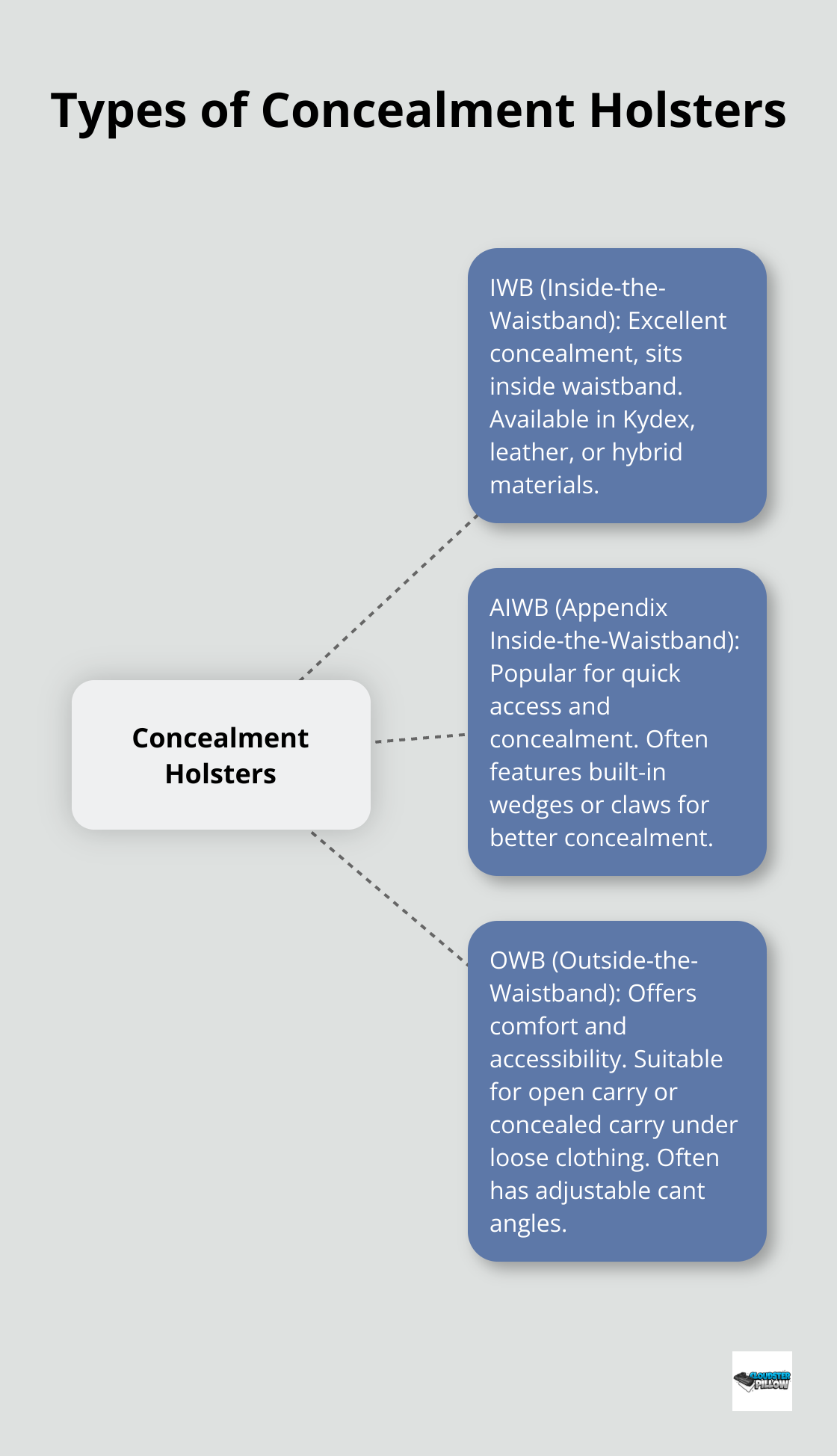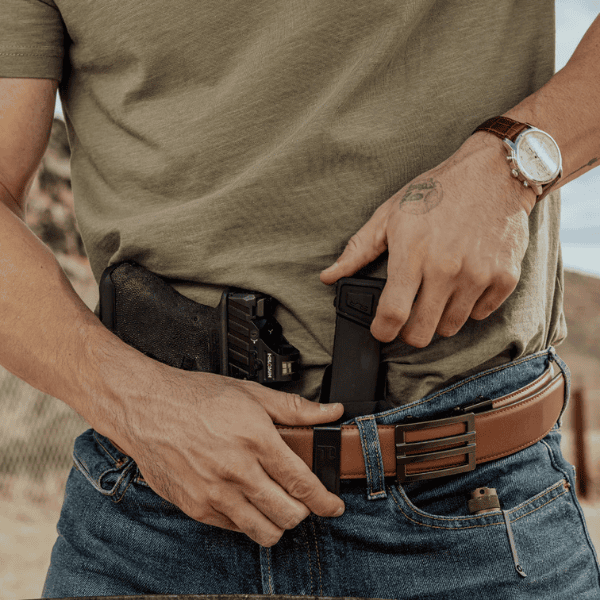Holsters and Gear Recommendations, Carry Techniques and Optimization
How Do I Set Up My EDC Belt and Holster for Maximum Concealment?
At Cloudster Pillow, we understand the importance of a well-planned EDC belt and holster setup for effective CCW concealment.
Mastering concealed carry requires more than just choosing the right firearm. It’s about creating a seamless system that prioritizes both comfort and discretion.
In this guide, we’ll explore the key elements of optimizing your EDC belt, selecting the ideal holster, and fine-tuning your carry position for maximum concealment.
What Makes a Great EDC Belt?
The Foundation of Effective Concealment
A high-quality EDC belt forms the cornerstone of your concealed carry setup. It provides the stability and support necessary for your firearm and holster.
Rigidity: A Non-Negotiable Feature
A sturdy, purpose-built gun belt is essential. It provides the necessary support, safety, and comfort for effective everyday carry. The National Shooting Sports Foundation reports that 78% of concealed carriers prioritize belt rigidity when selecting their EDC gear.

Premium Materials for Durability
Top-tier EDC belts use materials like full-grain leather or reinforced nylon. These offer an optimal balance of durability and flexibility. Industry reports indicate a 35% increase in sales of Kydex-reinforced belts over the past year.
Width: Finding the Sweet Spot
Belt width significantly impacts comfort and concealment. Most holsters accommodate 1.5-inch belts, which provide excellent support without drawing attention. Some users (particularly those carrying larger firearms) prefer 1.75-inch belts for added stability.
Low-Profile Buckle Designs
Traditional belt buckles can create unnecessary bulk. Many EDC enthusiasts choose low-profile or cobra-style buckles to maintain a sleek appearance. For example, Nexbelt offers EDC belts with innovative ratchet belt technology and customizable designs.
When you select your EDC belt, prioritize function over fashion. A well-designed belt costs more upfront but proves invaluable for your safety and comfort. Your entire concealed carry system depends on this foundation, so choose carefully.
Now that we’ve covered the essentials of a great EDC belt, let’s move on to selecting the right holster to complement your setup.
Choosing the Right Concealment Holster
Selecting an appropriate concealment holster plays a vital role in effective everyday carry. The market offers various options, each with unique advantages for different carry styles and body types.

Inside-the-Waistband (IWB) Holsters
IWB holsters excel in concealment capabilities. They sit inside your waistband, keeping your firearm close to your body. Personal preference plays a significant role in choosing the right IWB holster. Some users find that with the right pants, an IWB holster can even function as a pocket holster.
When you select an IWB holster, consider the material. Kydex provides durability and a consistent draw, while leather molds to your body over time. Hybrid designs combining both materials have gained popularity.
Appendix Inside-the-Waistband (AIWB) Holsters
AIWB carry has become increasingly popular, especially among younger carriers. This position offers quick access and excellent concealment for most body types.
When you choose an AIWB holster, prioritize those with built-in wedges or claws. These features help tuck the grip of your firearm closer to your body, reducing printing. The Cloudster Pillow significantly enhances comfort in this position, addressing a common complaint about AIWB carry.
Outside-the-Waistband (OWB) Holsters
While less concealable, OWB holsters offer comfort and accessibility. They work well for open carry or concealed carry under loose-fitting clothing.
Try to find OWB holsters with adjustable cant angles. This feature allows you to customize the draw angle and improve concealment under a cover garment.
Concealment-Enhancing Features
Modern holsters incorporate innovative features to maximize concealment. Wings and claws leverage your belt to pull the grip of your firearm closer to your body. Wedges (like those found on some popular holster models) create space between the muzzle and your body, reducing printing.
For carriers who want an extra edge in comfort and concealment, our Holster Wedge offers a simple yet highly effective upgrade. Designed to attach to all IWB and AIWB holsters, the Holster Wedge fills the gap between your holster and your body, angling your firearm for a tighter, more discreet fit. This not only minimizes printing but also helps distribute pressure, reducing hot spots during all-day wear.
The ModWing is a standalone piece of concealment-enhancing hardware that allows a user’s belt to apply additional leverage by rotating the holster and the grip.
Your daily activities, clothing choices, and body type should guide your holster selection. Don’t hesitate to experiment with different options to find the perfect fit. The most effective holster is one that you’ll consistently wear and practice with.
Now that we’ve covered holster selection, let’s explore how to optimize your carry position for maximum concealment and comfort.
Where Should I Position My Firearm?
Appendix Carry: Speed and Concealment
Appendix carry (AIWB) offers rapid draw times and excellent concealment for most body types. Your draw to 1 round fired should be under 2 seconds regardless of carry position. However, some users report discomfort when sitting for extended periods.
Strong-Side Hip: Classic and Adaptable
The 3-5 o’clock position balances accessibility and comfort. It accommodates various clothing styles but may print more noticeably than AIWB, especially with larger firearms.
Behind the Hip: Comfort for Larger Frames
Carrying at 4-5 o’clock can increase comfort for individuals with larger body types. This position often requires a slight twist to access your firearm, which might slow your draw.

Tailoring Your Setup
Adjust your holster to optimize concealment and draw speed. Quality holsters offer adjustable cant and ride height. Experiment with these settings to find your ideal balance.
For AIWB carriers, a wedge can improve comfort and reduce printing. The Cloudster Pillow excels in this role, providing customizable support that molds to your body shape.
Strong-side carriers should consider holster cant. A positive cant increases concealment due to the handgun’s barrel resting at a different angle.
Body-Specific Considerations
Your body type influences the most effective carry position. Slimmer individuals often conceal AIWB more easily, while those with a larger midsection may prefer strong-side or behind-the-hip positions.
Height also matters. Carrying your holster at the right height can significantly improve your comfort level, especially for everyday carry.
FAQs
1. How do I set up my EDC belt and holster for maximum concealment?
To optimize your EDC belt and holster setup for maximum concealment, start with a rigid, purpose-built gun belt that provides support and stability. Choose a holster designed for your carry style (IWB, AIWB, or OWB) and ensure it has concealment-enhancing features like claws or wedges. Adjust your holster’s cant and ride height for comfort and effective concealment. Don’t forget to experiment with different combinations to find what works best for your body type and daily activities.
2. What makes a great EDC belt for concealed carry?
A great EDC belt for concealed carry should be rigid enough to support the weight of your firearm and holster, without sagging. Premium materials like full-grain leather or reinforced nylon offer durability and flexibility. The belt width should ideally be 1.5 inches for most holsters, while 1.75 inches can provide added stability for larger firearms. A low-profile buckle design helps maintain a sleek, discreet appearance.
3. What is the difference between IWB, AIWB, and OWB holsters?
IWB (Inside-the-Waistband) holsters are worn inside the waistband and offer excellent concealment by keeping the firearm close to your body. AIWB (Appendix Inside-the-Waistband) holsters sit at the front of the body, providing fast access and excellent concealment, especially for smaller frames. OWB (Outside-the-Waistband) holsters are worn on the outside of the waistband and offer comfort and accessibility, though they are less concealable and typically work best under loose-fitting clothing.
4. How do I choose the best carry position for my firearm?
The best carry position depends on your body type and comfort preferences. Appendix carry (AIWB) offers quick access and excellent concealment but can be uncomfortable when sitting for long periods. The strong-side hip (3-5 o’clock) offers a balance of comfort and accessibility, though it may be more noticeable for larger firearms. Behind the hip (4-5 o’clock) can provide comfort for larger body types but might slightly slow the draw due to the position.
5. How can accessories like the Cloudster Pillow improve my EDC setup?
Accessories like the Cloudster Pillow can enhance both comfort and concealment by filling the gap between your holster and body. It helps distribute pressure, reducing discomfort from hot spots during extended carry. It also helps reduce printing, making it an excellent choice for IWB and AIWB carriers looking to achieve a more discreet and comfortable setup.
Final Thoughts
Mastering concealed carry demands a thoughtful approach to your EDC belt and holster setup. You must select a rigid, purpose-built belt and pair it with a holster that complements your body type and carry style. This combination creates a foundation for effective CCW concealment. The most important factors are consistency and comfort – choose a setup you will wear every day.
Experimentation plays a vital role in finding the right combination. Different combinations of belts, holsters, and carry positions work for different individuals. Pay attention to how your gear interacts with your daily activities and wardrobe. Practice will help you develop a system that feels natural and comfortable.
Consider accessories that enhance both comfort and concealment as you refine your setup. The Cloudster Pillow offers customizable support that can improve the comfort of inside-the-waistband and appendix carry positions. It also helps reduce printing, which is essential for effective concealed carry.

